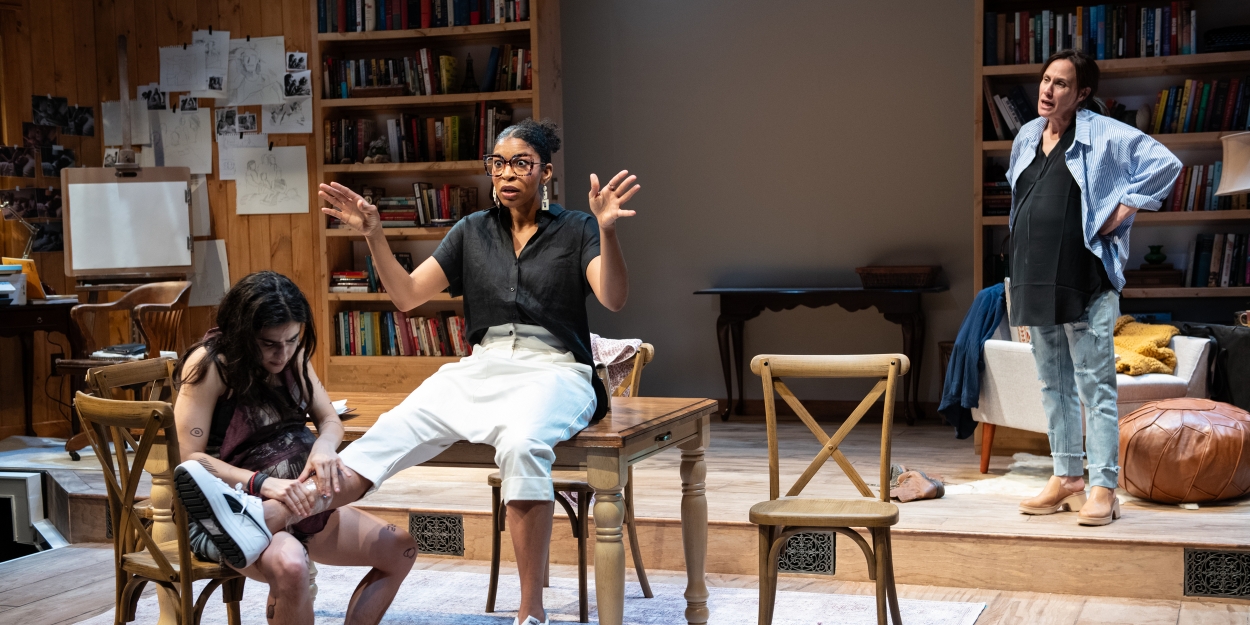Review: PROBLEMS BETWEEN SISTERS at Studio Theatre
Visceral and joltingly immersive.

The submerged and, often, long-sublimated divisions and resentments and life motifs of two estranged sisters come to the fore in the visceral and joltingly immersive play entitled Problems Between Sisters. The domestic squabbles of siblings have long been given ample space in plays, films, and novels but, in this fine Studio Theatre production, the playwright Julia May Jonas delves into a feminist mirroring and elucidation of themes from playwright Sam Shepard’s well-known play True West. In this intriguing play, the battling brothers become two sisters, California becomes Vermont and screenwriting becomes visual and performance art.
The recriminations and resentments (as well as moments of shared laughs and affection) come most alive when primal desires for different visions of “what constitutes success and/or failure in a competitive world”, “who deserves to be recognized and given attention” and “differing gradations as to what are the duties of one sibling to another when a sibling’s life circumstances have been changed” are explored and thrashed-out.
Luckily, director Sivan Battat has siblings squabbling, explosive physical and mental psychodynamics, the clever mirroring of True West, and the taut direction of a dynamic group of actors all sitting nicely in the palm of her directorial hands. There is a wealth of emotional and thought-provoking fodder for a rewarding evening or afternoon at the theatre here-- but be forewarned that this is “in your face” theatre with a good amount of intense quarreling and even physical wrangling. (I was often thinking that playwright Ms. Jonas as well as Mr. Shepard may have been channeling the influence of such experimental theatre directors as Jerzy Grotowski or Joseph Chaikin either overtly or subliminally---. I also thought of Albee’s Who’s Afraid of Virginia Woolf? as regards the verbal fireworks).
The feminist quality in the play was re-invigorated as the two siblings’ (Stephanie Janssen as Jess and Annie Fox as Rory) characters were pregnant throughout and this certainly intensified the idea of rebirth through the lens of the archetype of the woman-- as well as through art as a life force. In the play, the character of Jess is the ostensibly more organized and “professional” of the two sibling characters; she is a visual artist with a chance at rising even higher in her profession when the arrival of her more outwardly unruly and sassy, quick-witted sister throws her seemingly ordered world inside -out and vice-versa.
As incidents, comments and provocations arise---especially in what constitutes notions of “success” (here I often thought of David Mamet) ---director Battat expertly conveys Ms. Jonas’ brilliant delineation of the two siblings subtly becoming the mirror images of the personalities they initially detested in the other. (I often thought of Bergman’s film “Persona” in this regard). The birth motif is again accentuated via some symbolically bizarre performance art only to give way to such a fireball of familial love and hate, that the death wish is also given free rein. (The animalistic fight for survival also exists in families).
Thank the playwrighting skill of Ms. Jonas for the alternately sassy, volcanic humor that is combined with the caustic humor and dry wit that runs like a thread in the siblings’ interactions. Stephanie Janssen as the more ostensibly articulate Jess captures this aspect well and she also runs the entire gamut of emotions with nuance and finesse. Annie Fox as the more ostensibly “heart on her sleeve” character of Rory, beautifully conveys the raw cunning and defiance necessary to be competitive in a harsh world that often judges people by outward manner and appearance only. The physical stamina required of both actors Janssen and Fox is almost impossible to convey.
Maya Jackson as the character Anita was perfection as the personification of the professional business type that will inevitably find their advantage when dealing with differing personalities and working styles.
The marvelous Nancy Robinette as Aunt Barb had a small amount of stage time-- but she practically stole the show with a dryly bemused performance that was replete with a soupcon of pure eccentricity.
Technical components of the show were aligned well with the content and intentions of the production. The set design by Emmie Finckel was nicely functional, costume design by Helen Q. Huang was creatively appropriate, and lighting design by Colin K. Bills was highly effective.
Interesting music was played at intervals and heightened moments--- I believe I recognized bluegrass style music and Joni Mitchell’s “Coyote”; they lent a “rough and ready” atmospheric sound to the play. Fight and movement coordinator Ashleigh King’s talents were on obvious display.
If you are intrigued by a well-produced, somewhat specialized, provocative, and explosive trip to the theatre –do not miss playwright Julia May Jonas’ world premiere of Problems Between Sisters.
Running Time: One Hour and 50 minutes including a fifteen-minute intermission
Problems Between Sisters runs through June 16, 2024, in the Mead Theatre at Studio Theatre located at 1501 14th Street NW, Washington, D.C. 20005.
Photo Credit: L-R Annie Fox, Maya Jackson, and Stephanie Janssen in Studio Theatre's World Premiere production of Problems Between Sisters. Photo by Margot Schulman.
Comments
.png)
|
.png)
|
Videos

